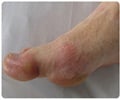Even as the number of gout cases in the UK has soared over the last two decades, with one in every 40 people now suffering from the condition, the level of treatment continues to remain poor.

The researchers used the Clinical Practice Research Datalink (CPRD) to estimate both the prevalence and incidence of gout in the UK between 1997 and 2012.
The CPRD, formerly the General Practice Research Database until it was renamed in 2012, is one of the largest databases of long term primary care medical records in the world, holding those of around 12 million of the UK population.
The researchers also looked at treatment for those who already had gout and those who were newly diagnosed (within six to 12 months) to see how well their condition was being managed.
Among more than 4.5 million eligible people on the database in 2012, almost 116,000 already had gout, giving a prevalence of 2.5%.
Men were significantly more likely to have been diagnosed with the condition than were women, peaking at a ratio of 11:2 between the ages of 35 and 39. Gout was rare among those younger than 20.
Advertisement
The gender gap for diagnosis was at its widest for those aged 30-34, but new cases of gout were highest among those aged 80-84, for both sexes.
Advertisement
The number of new cases rose by 30% during this time, increasing by around 1.5% each year. Men were around three times as likely to be diagnosed with the condition as women across the entire period.
The patterns of both prevalence and incidence varied widely across the UK, with prevalence highest in the North East of England and Wales, and lowest in Scotland and Northern Ireland.
New diagnoses were lowest in the East of England and Northern Ireland and again highest in Wales and the North East of England.
Only a third of people with gout were being treated with urate lowering drugs, a percentage that remained constant over the entire period.
In 2012, fewer than one in five patients was prescribed these drugs within six months of their diagnosis, and only around one in four was on this treatment a year after diagnosis - a pattern that remained more or less unchanged since 1997, despite the publication of guidelines on optimal management of the condition.
Patients got better at taking their drugs, with around four out of 10 doing so in 2012, compared with 28% in 1997, but these figures are still not a cause for celebration, say the authors.
Source-Eurekalert






